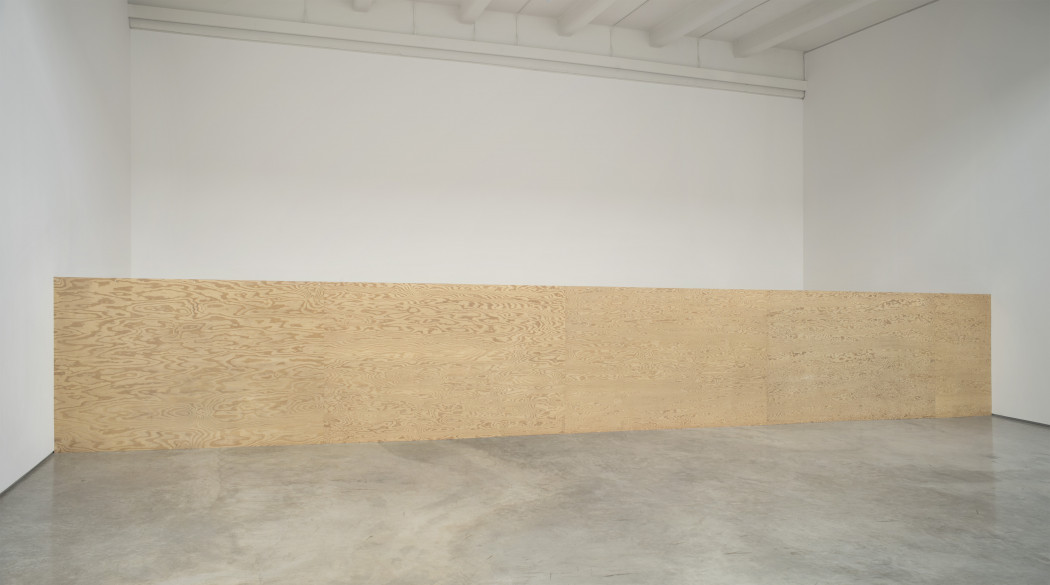Donald Judd
Long-term view, Dia Beacon
Overview
On view in these galleries is a focused presentation of Donald Judd’s iconic plywood works from the 1970s, which exemplify the artist’s ability to produce exquisitely complex works by combining essential geometry and common industrial materials. Starting in the 1960s Judd determined a basic vocabulary of materials and forms that he would use throughout his practice, placing simple geometric boxes directly on the floor or spaced evenly along the wall. In forgoing the pedestal, he engages viewers in a bodily experience that happens in real time and space. Judd rejected traditional notions of craftsmanship in favor of an industrial production more true to the nature of his materials, delegating the fabrication of his objects to specialized technicians who followed instructions and sketches provided by the artist.
In the 1960s Donald Judd began placing simple geometric boxes directly on the floor or spaced evenly along the wall. In forgoing the pedestal, he engaged viewers in a bodily experience that happened in real time and space. Within a decade he began exploring the contingencies of space and the parameters of perception on broader terms, as in Untitled (1976). This work slowly reveals itself as it is approached. The plywood wall gives way to a sloping plane that divides the gallery into two inaccessible volumes. Originally fabricated for the Paula Cooper Gallery in New York City, the work is adapted to the dimensions of each new site. The secant angle shifts according to the width of the wooden barrier. While resolutely abstract, Untitled is emblematic of Judd’s belief that “actual space is intrinsically more powerful and specific than paint on a flat surface.”
Judd’s complicated relationship to painting is evident in his many wall-mounted structures and his persistent and varied use of color. Rejecting the proscriptions of both painting and sculpture, he focused instead on three-dimensional objects which, he argued, “can have any relation to the wall, floor, ceiling, room, rooms, or exterior or none at all.” Untitled (1975) and Untitled (1991) both consist of a series of wall-mounted boxes that project into space. To avoid any external references, Judd arranged these structures in non-hierarchical order, respectively using a simple line and grid. In a further attempt to reject the illusionism of painting, Judd incorporated color into these series through the use of Plexiglas—a material that assimilates color as an inherent rather than superficial quality.
Early in his career Judd determined a basic vocabulary of materials and forms that he would use throughout his practice. Judd was interested in developing an aesthetic free from any historical or metaphorical associations. He identified and deployed new industrial materials—such as anodized aluminum, Plexiglas, and plywood—that had no precedent in the visual arts. These were used in the construction of square planes, cubes, and rectangular pipes. Rejecting traditional notions of craftsmanship in favor of an industrial production more true to the nature of his materials, Judd delegated the fabrication of his objects to specialized technicians who followed instructions and sketches provided by the artist.
Donald Judd was born in Excelsior Springs, Missouri, in 1928. He attended Columbia University, studying philosophy from 1949 to 1953 and art history with Meyer Schapiro from 1957 to 1962. At the same time that he launched an impressive career as an art critic and polemicist, he began to produce his earliest paintings. He had forged his mature aesthetic by 1965. The Whitney Museum of American Art, New York City, organized a retrospective in 1968, and a one-person exhibition was shown at the National Gallery of Canada, Ottawa, in 1975. During his lifetime, Judd received a Guggenheim Fellowship in 1968 and the Skowhegan Medal for Sculpture in 1987. In 1986 a permanent installation of his work opened at the Chinati Foundation in Marfa, Texas. Judd died in New York in 1994.

1. Untitled, 1976
Douglas fir plywood
Dia Art Foundation; Gift of
Louise and Leonard Riggio
2. Untitled, 1975
Stainless steel and Plexiglass
Dia Art Foundation; Partial gift,
Lannan Foundation, 2013
3. Untitled, 1991
Douglas fir plywood and Plexiglas
Dia Art Foundation; Gift of
Louise and Leonard Riggio
Artist
Donald Judd
Donald Judd was born in Excelsior Springs, Missouri, in 1928. He died in New York City in 1994.
Selected Works on View

Donald Judd
Untitled, 1976
Go to Untitled page
Donald Judd
Untitled, 1991
Go to Untitled page
Donald Judd
Untitled, 1975
Go to Untitled pageExplore
Amie Siegel on Donald Judd
Move to Amie Siegel on Donald Judd pageCarol Bove on Donald Judd
Move to Carol Bove on Donald Judd pageErin Shirreff on Donald Judd
Move to Erin Shirreff on Donald Judd pageIman Issa on Donald Judd
Move to Iman Issa on Donald Judd pageJosiah McElheney on Donald Judd
Move to Josiah McElheney on Donald Judd pageMichael Craig-Martin on Donald Judd
Move to Michael Craig-Martin on Donald Judd pageRichard Deacon on Donald Judd
Move to Richard Deacon on Donald Judd page
Erin Shirreff on Donald Judd
Move to Erin Shirreff on Donald Judd page
Iman Issa on Donald Judd
Move to Iman Issa on Donald Judd page

